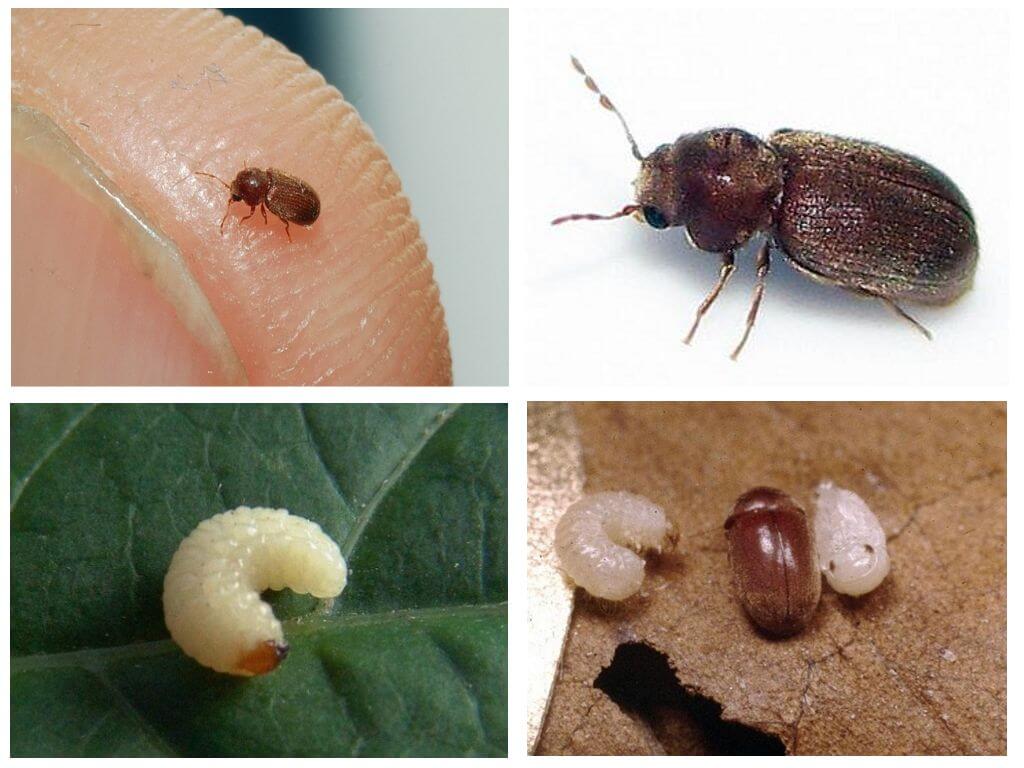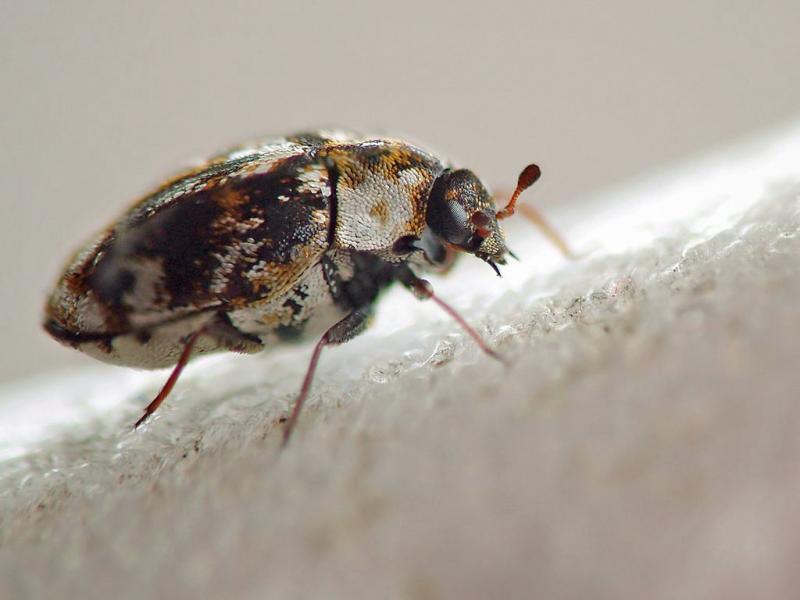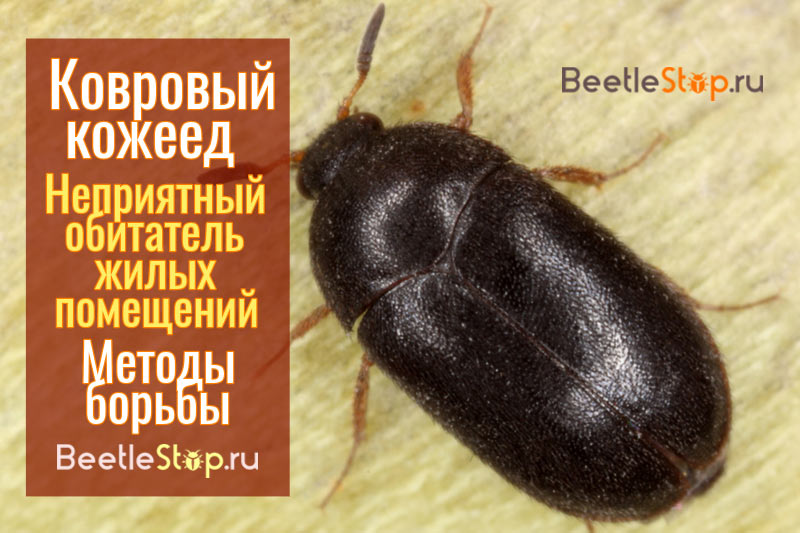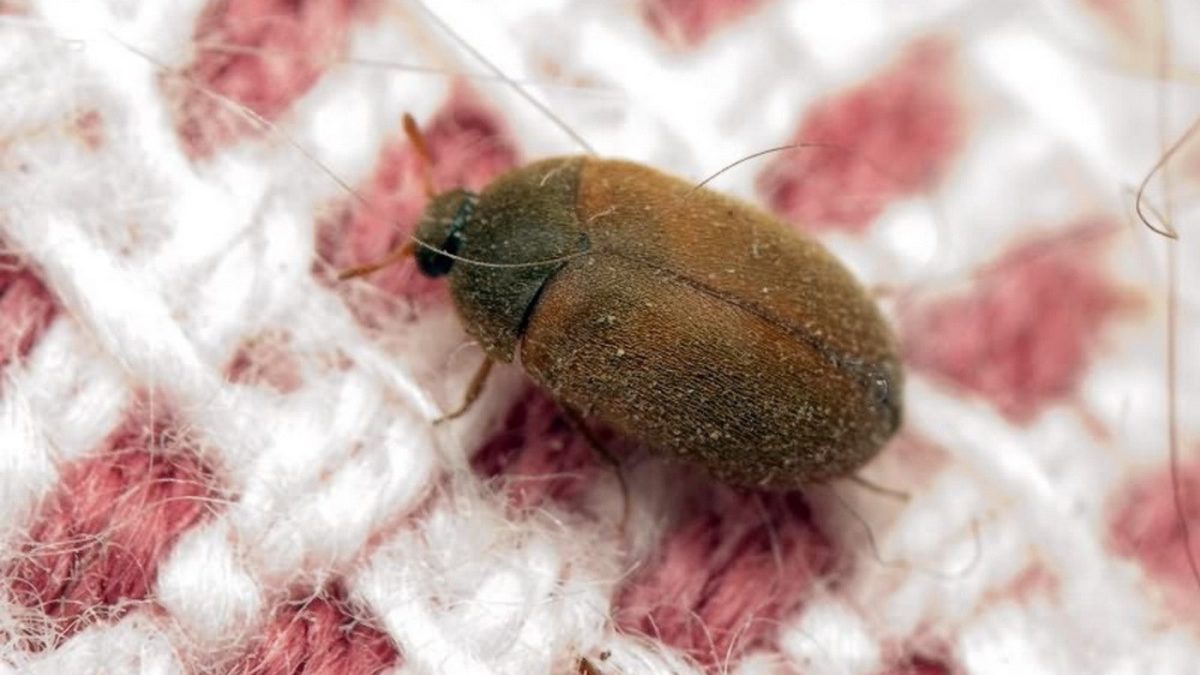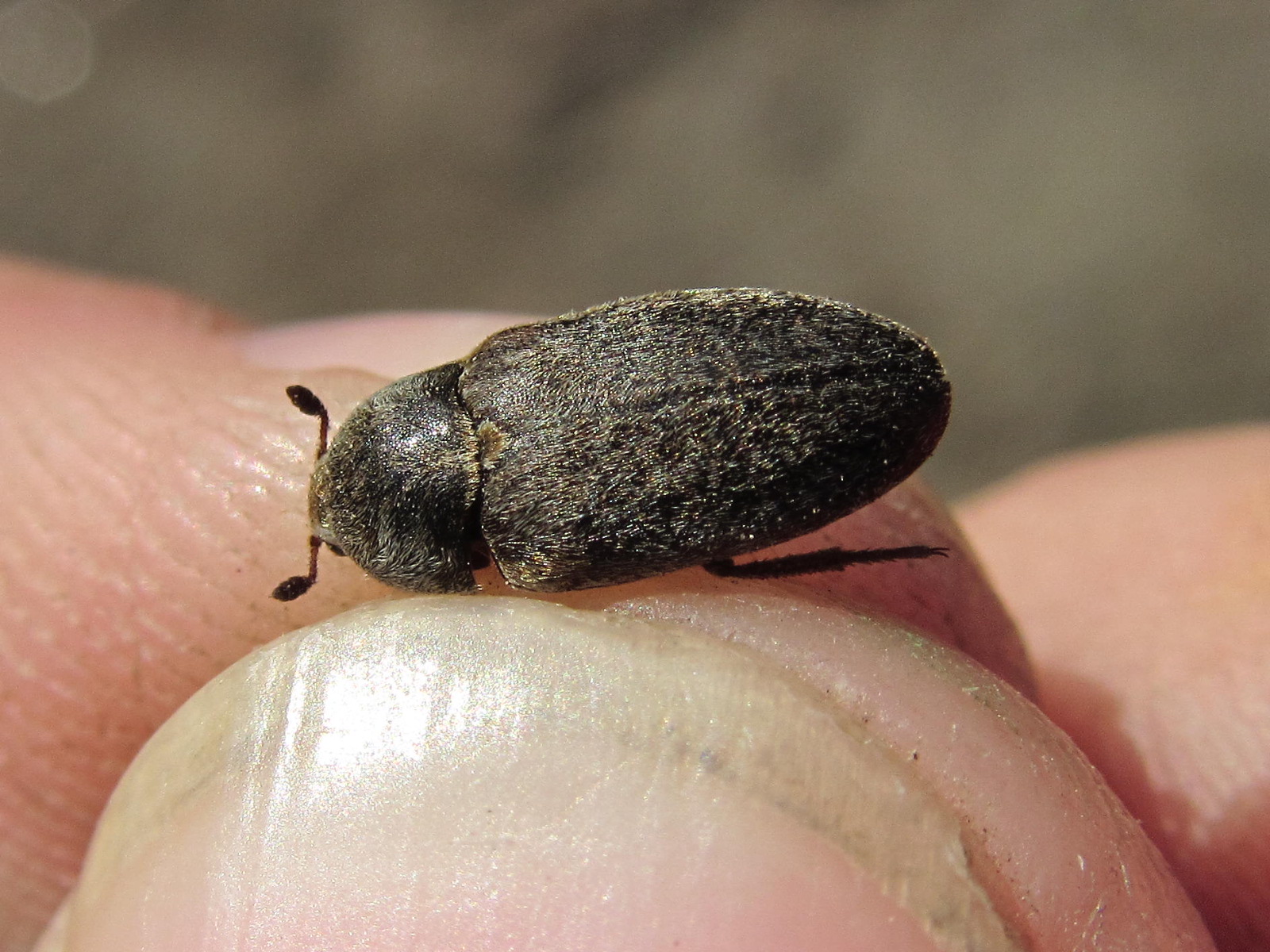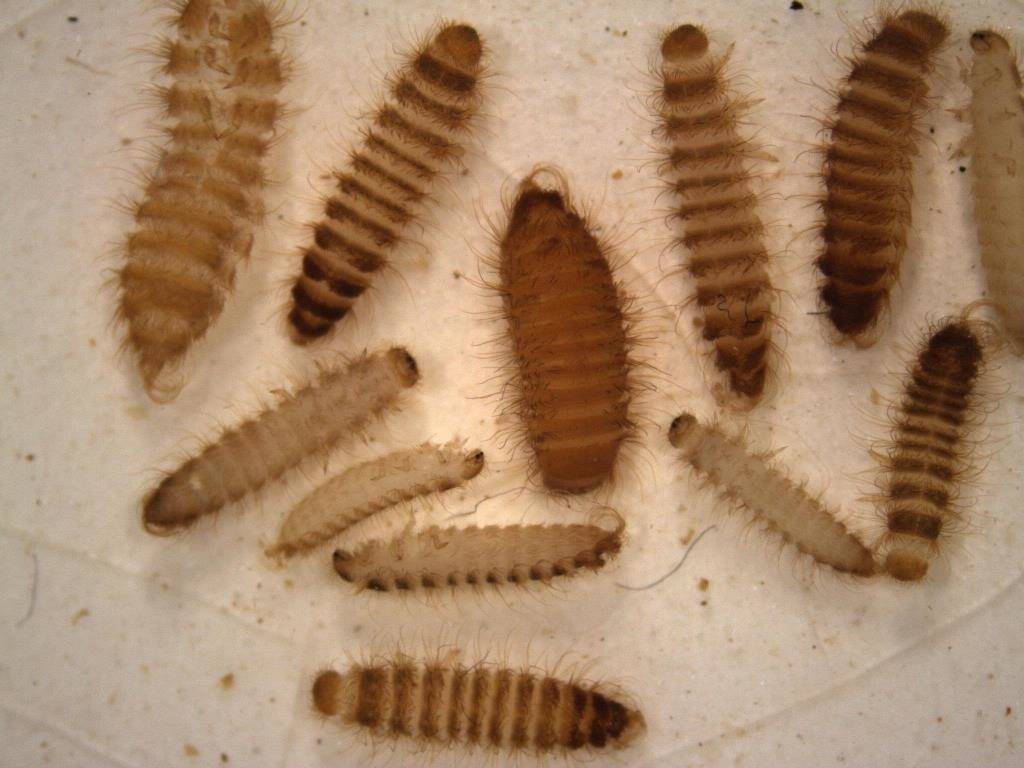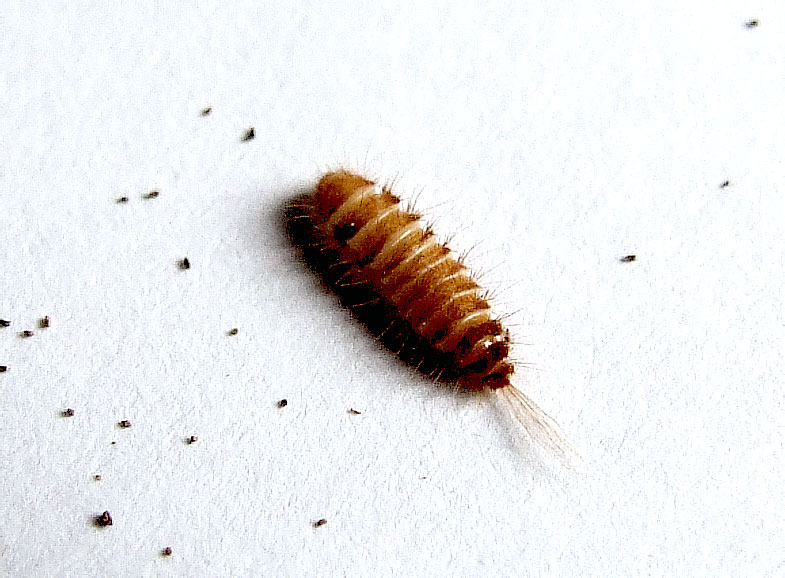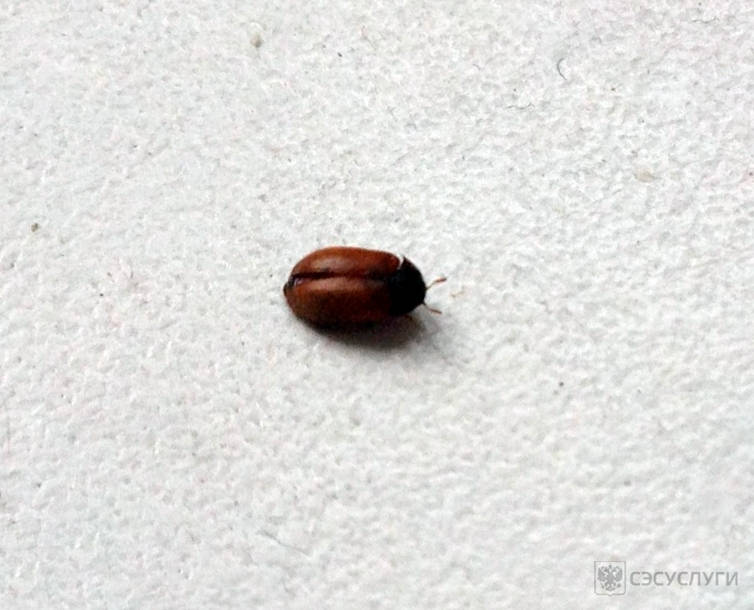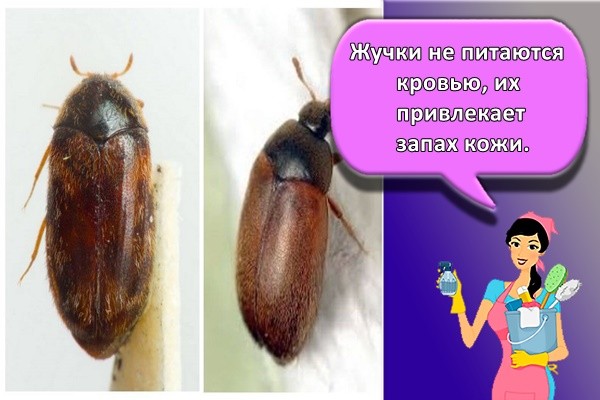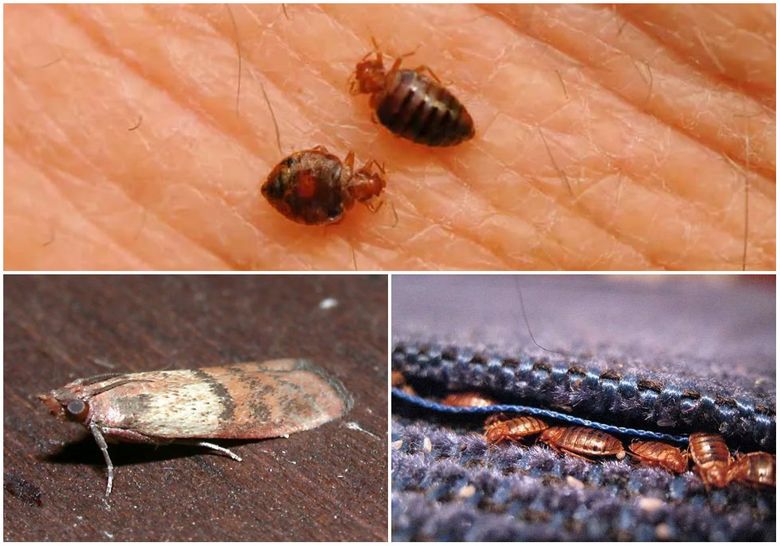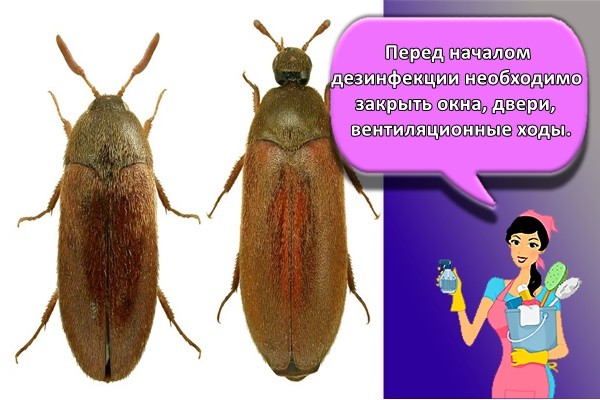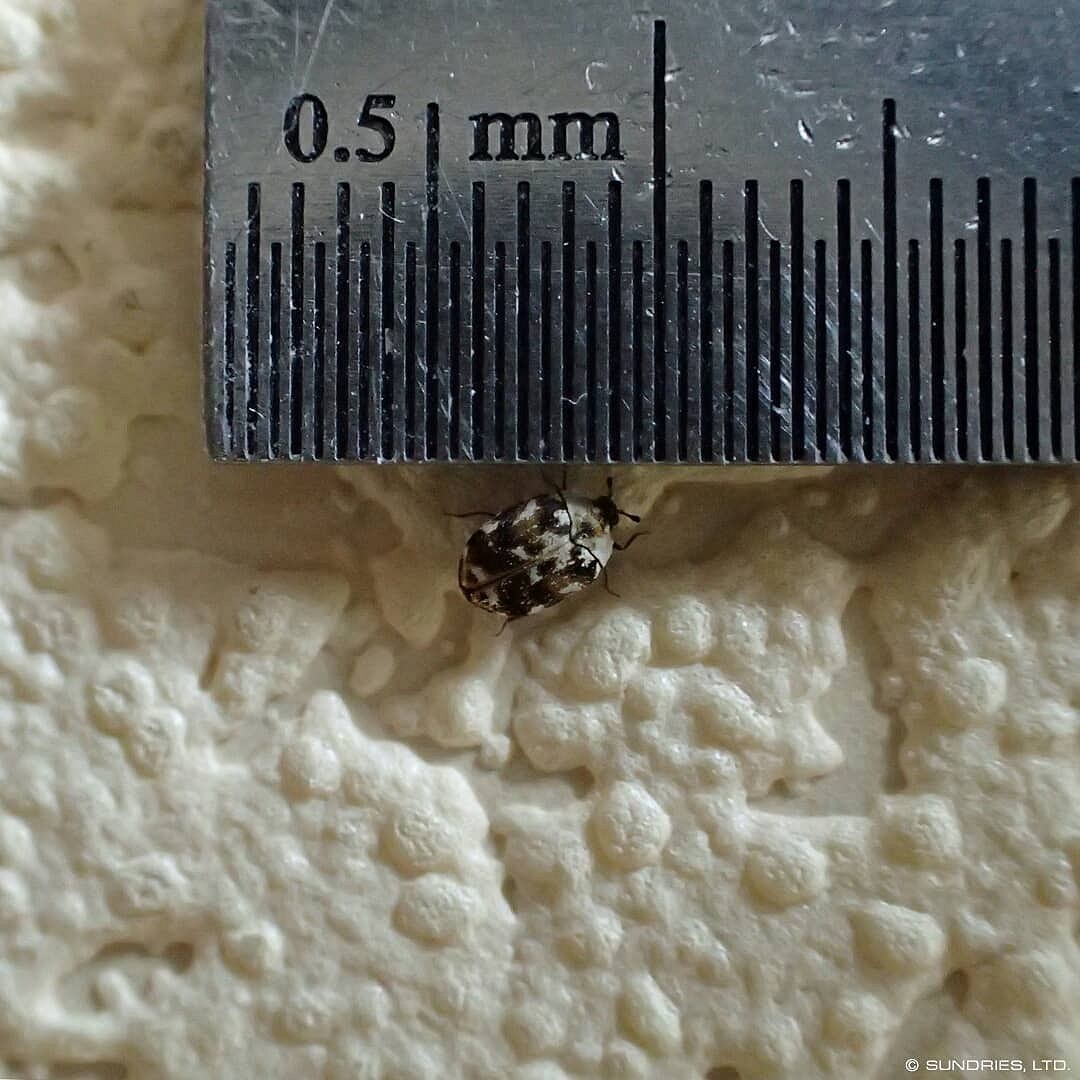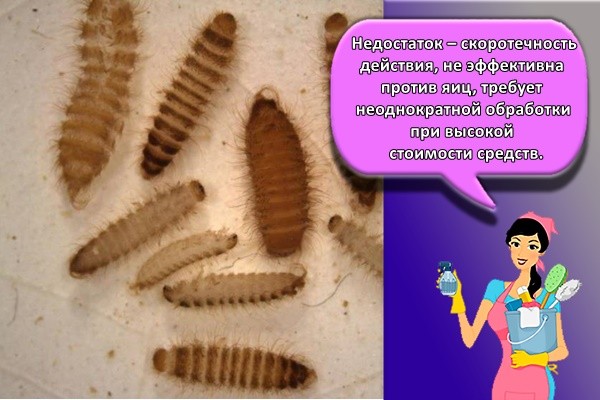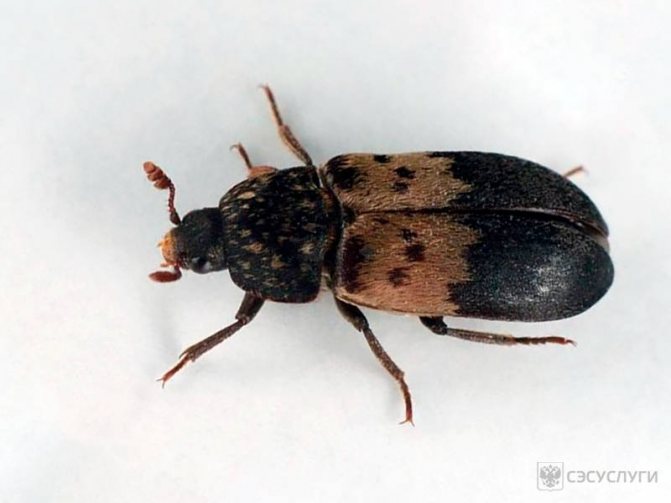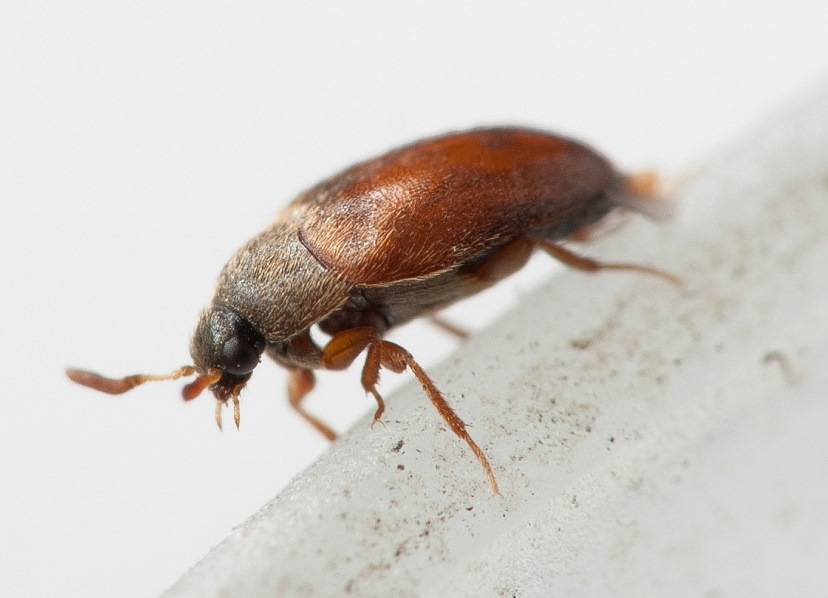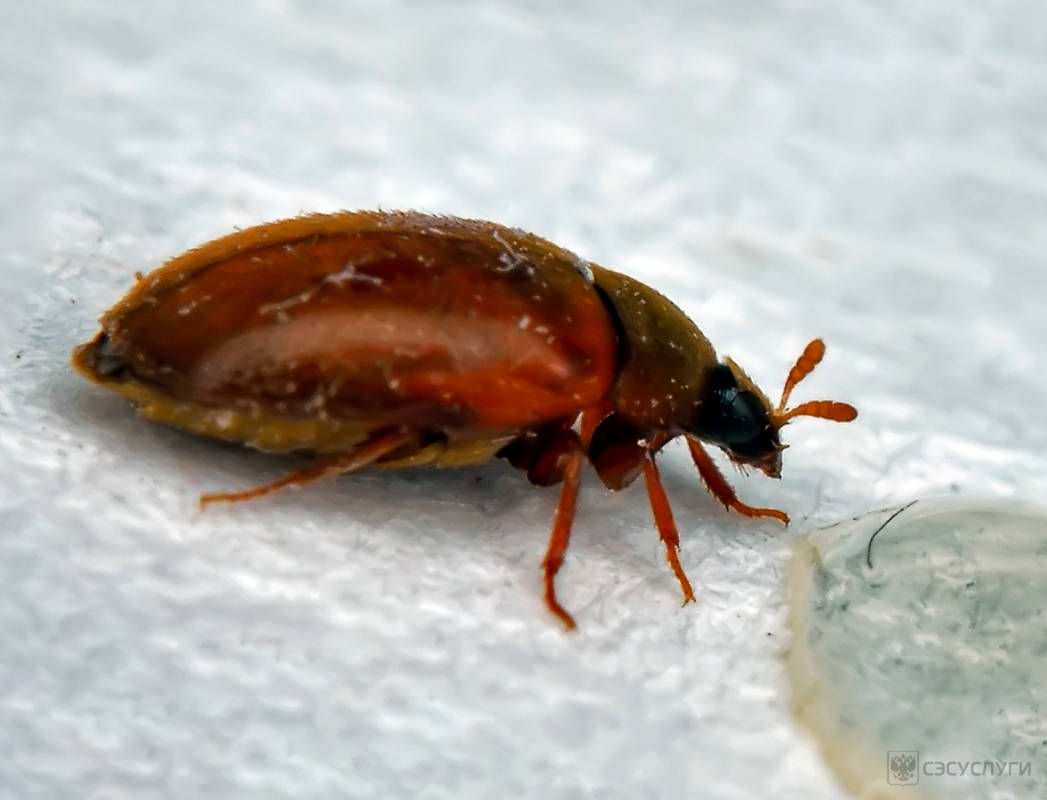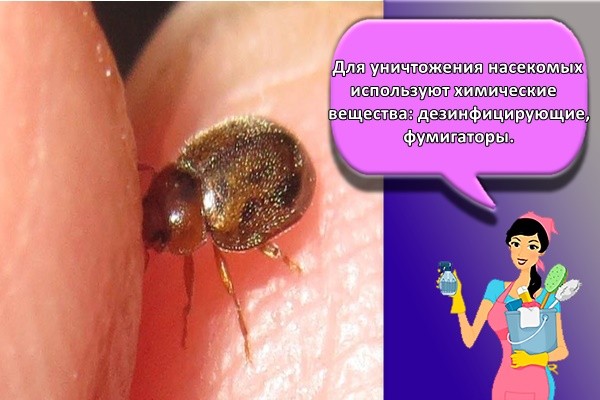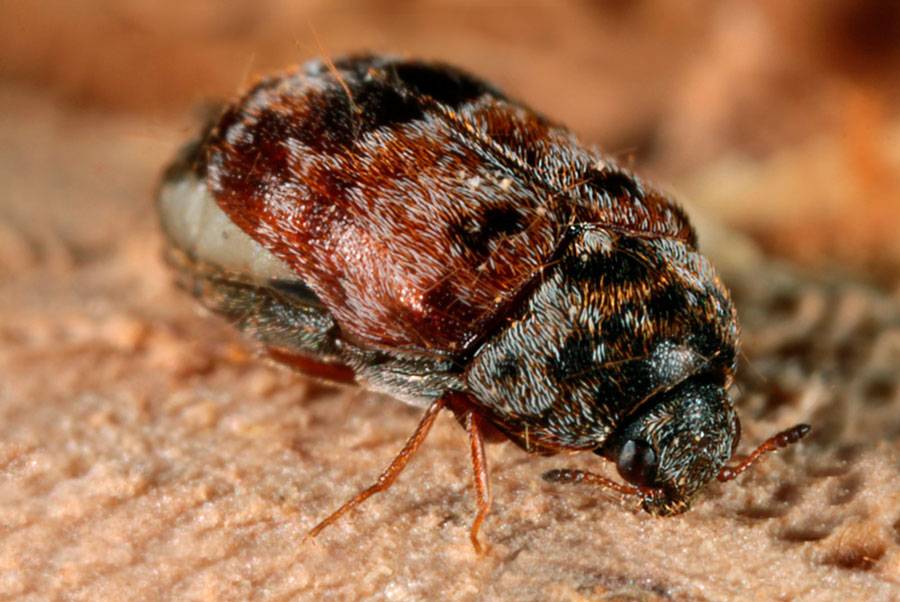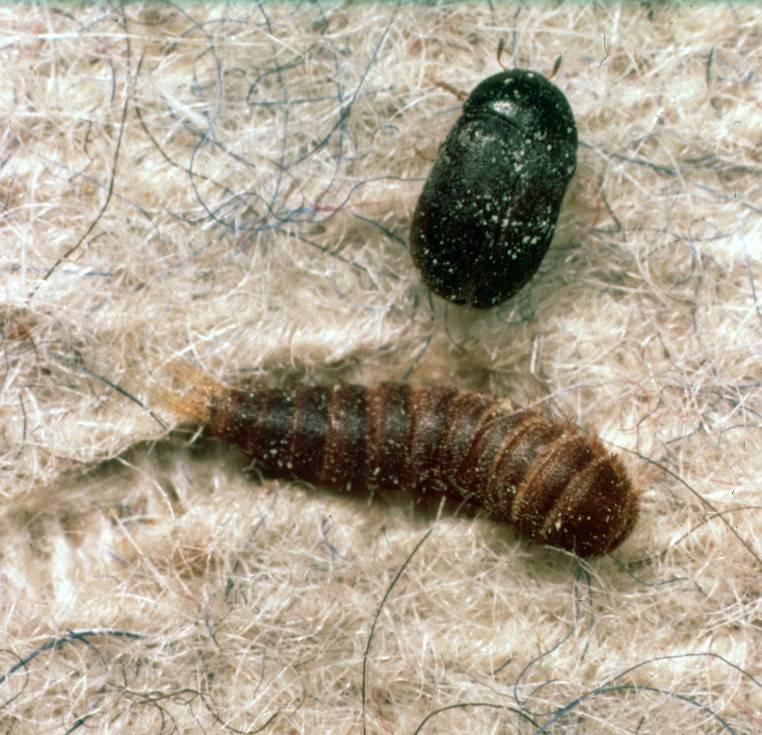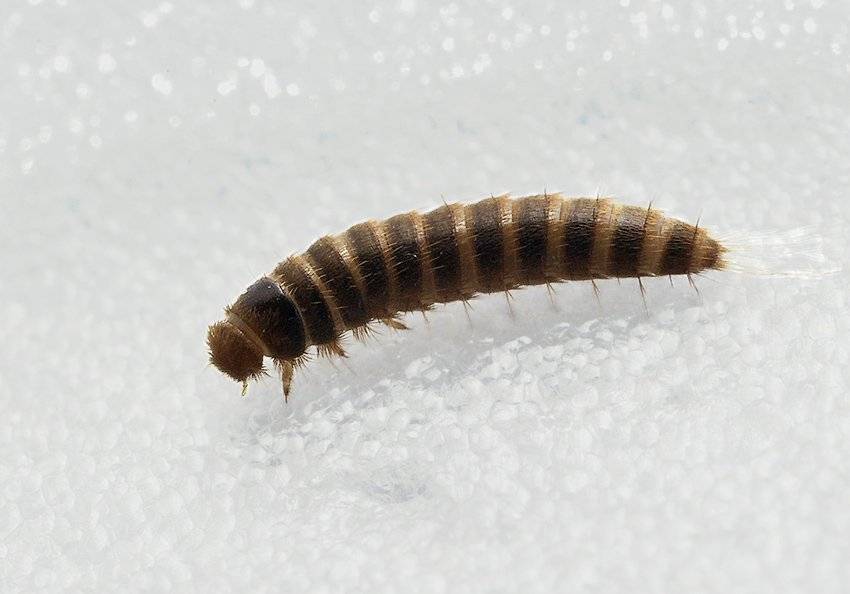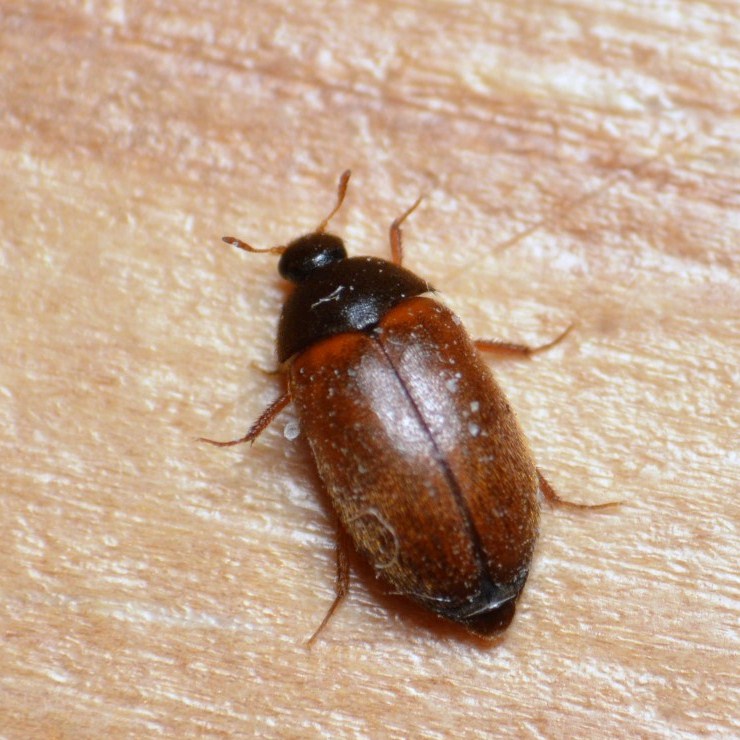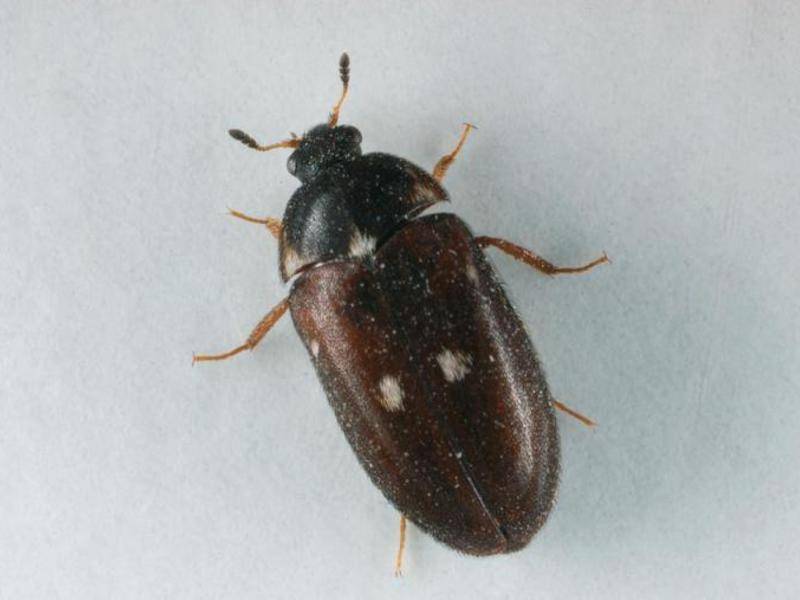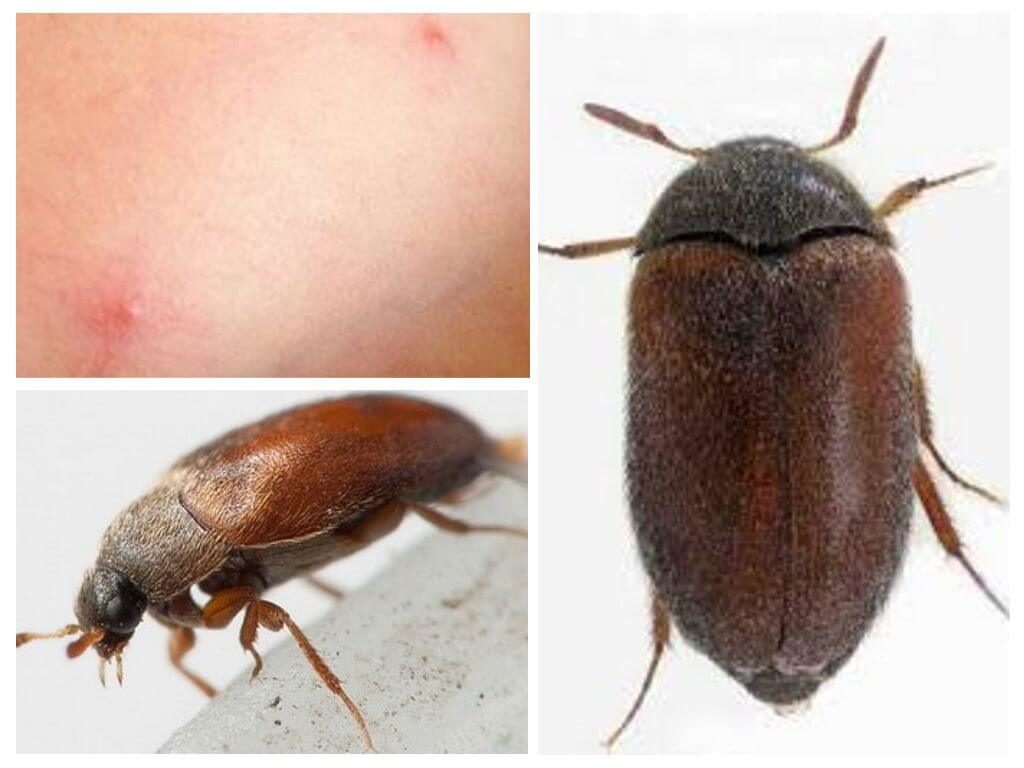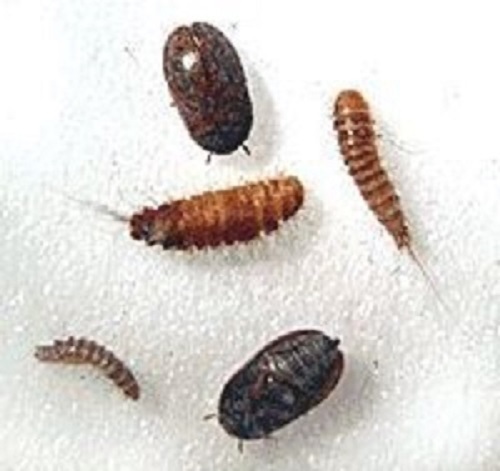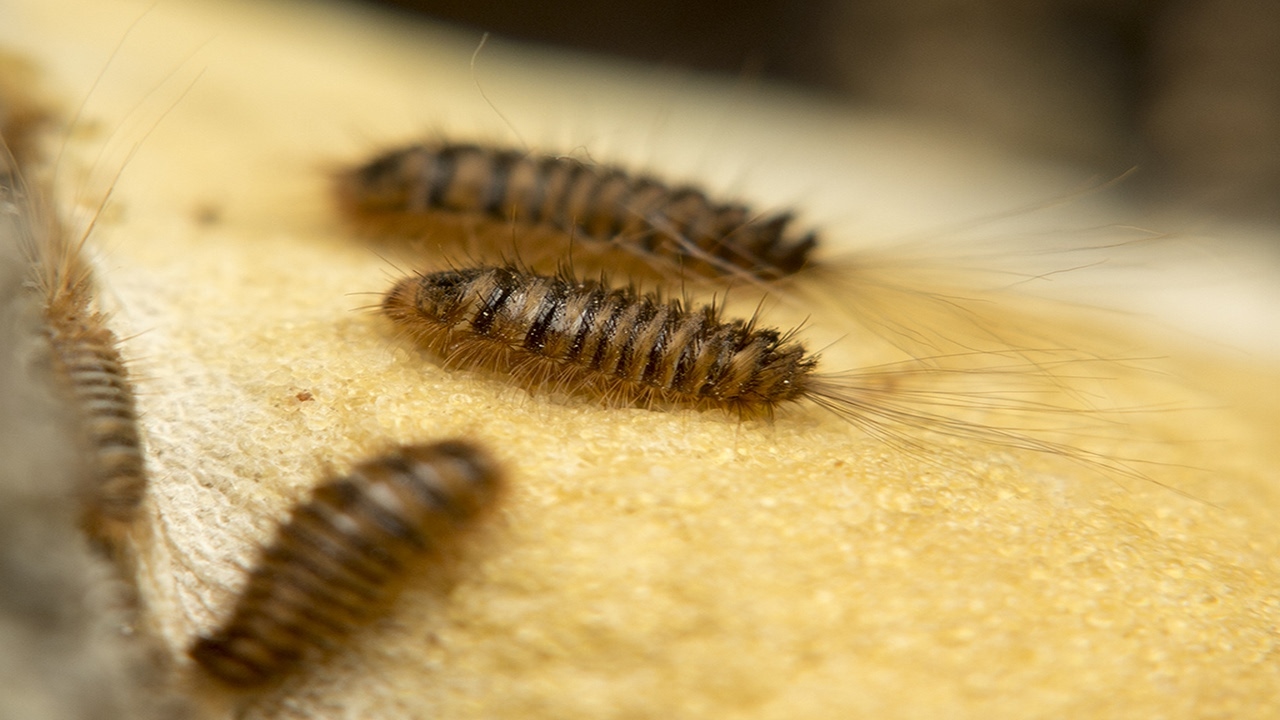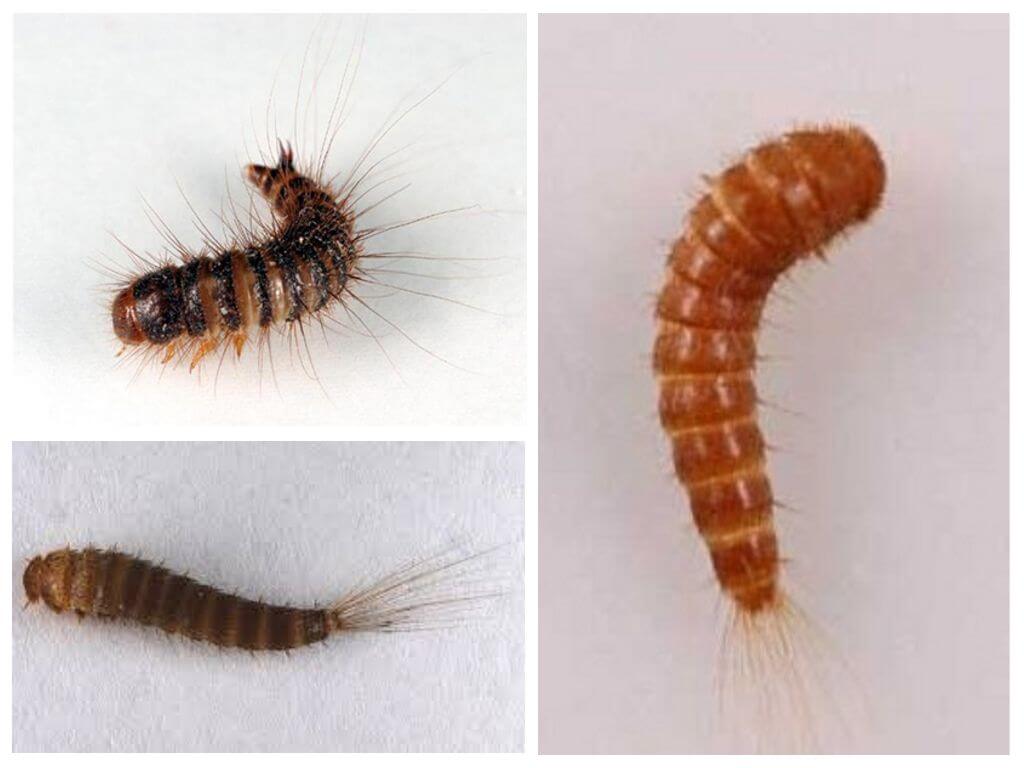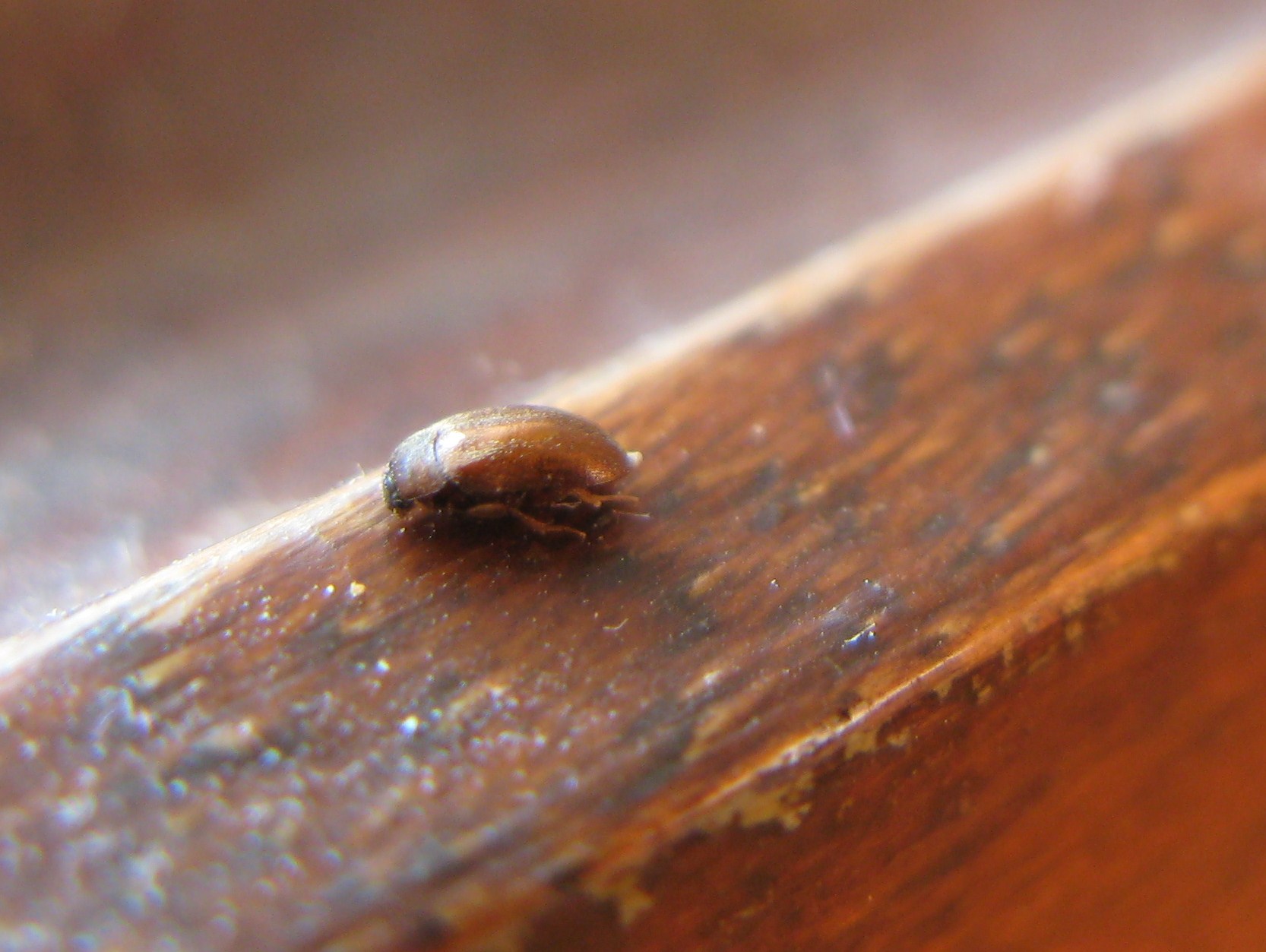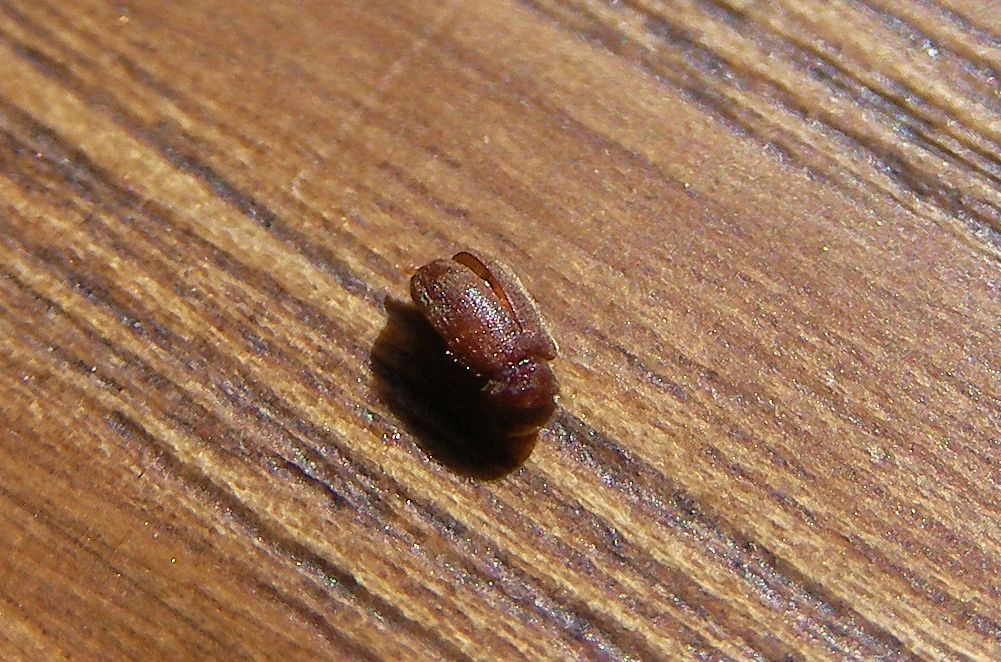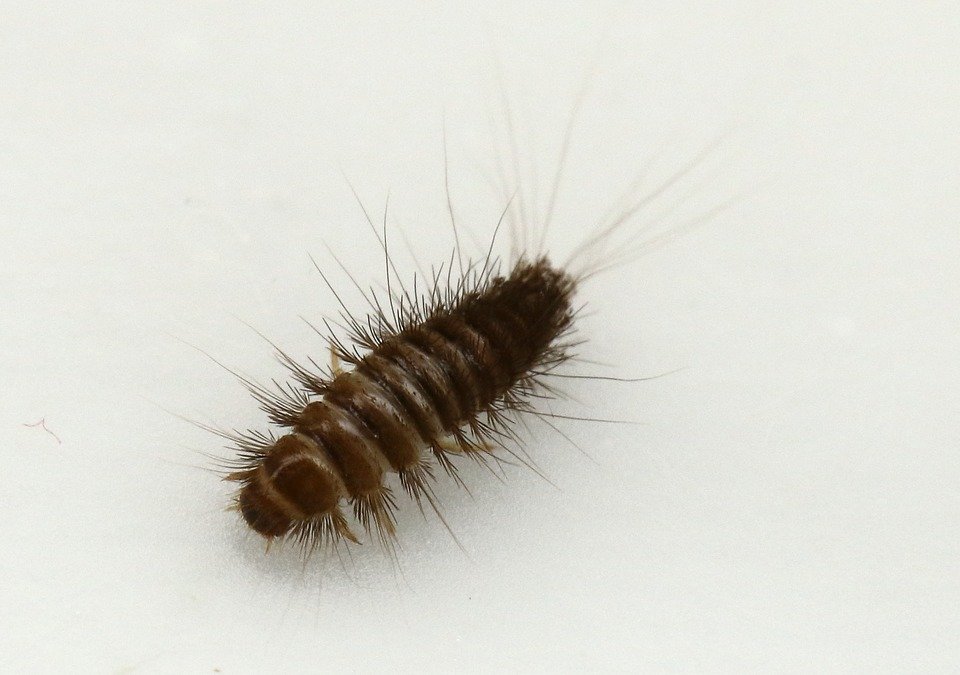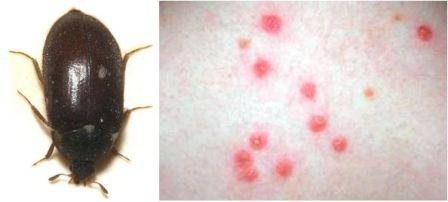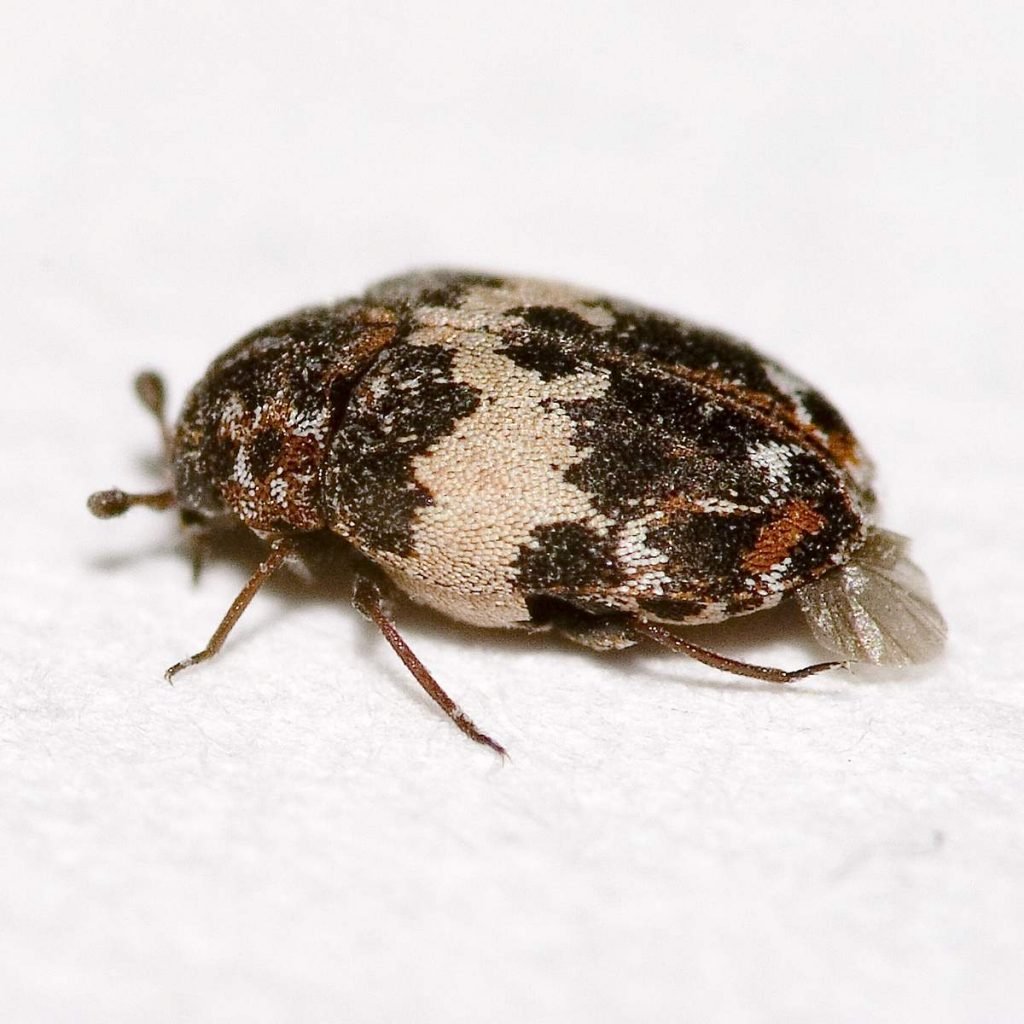Appearance and lifestyle
One of the smallest insects. Body length from 1.3 to 12 mm. It is rather difficult to spot one creature. Strong brown carapace. The color can be dark or reddish. The shape is oval, rounded. You can notice small stripes that stand out slightly in color. The whole body is covered with villi, and a long tuft hangs down in the form of a ponytail.
A new generation of kozheedov beetles appears in May. In this month, females mate and lay eggs. Places are chosen secluded and safe from the side of nutrition. Most often these are poorly ventilated rooms: warehouses, closets, basements. But when looking for food, they climb into the apartment. After 2–3 weeks, small, shaggy, dark caterpillars will appear. During the entire stage of development, the larvae molt 5–6 times and gradually turn into a beetle.
An adult is an almost harmless creature. It feeds mainly on plant sap. The larva of kozheedov beetles is very voracious, and the preferences are somewhat different. She gnaws everything that comes from natural material. It is interesting that this pest can go without food for a very long time - 4–5 years. At the same time, development is somewhat delayed, but does not stop completely. The whole process takes about 1 year. Less under favorable conditions. Insects are thermophilic. They love dry places with dim light.
Prevention measures
After you have managed to drive the pests out of your own home, do not forget about preventive measures so that the beetles do not attack it again.
- Damp clean regularly by adding a little vinegar to a bucket of water. It will be needed at the rate of 1 tablespoon per 1 liter of water, and then the beetles will forever forget their way to your home.
- Clean the floor and baseboards with a concentrated soap solution. Thus, you will be able to get rid of most of the larvae that have settled in the crevices.
- Take out the trash and wash the bucket in a timely manner.
- Vacuum your apartment at least once a week.
- Mosquito nets on the windows will be a good protection against pests entering the room.
- Do not store unnecessary things, free up space from various rubbish.
- Pack your shoes and clothes in special covers to prevent insects from damaging them.
- It is recommended to keep cereals in a glass container.
- Kozheedy cannot stand the smell of wormwood or lavender; spread dry herbs in the house.
- Use insect repellent plates.
Folk remedies in the fight against kozheedy
You can fight bugs with folk remedies. For example, using plants with a pronounced aroma - sage and lavender. Place the twigs in potentially hazardous areas, and place cotton pads soaked in essential oils in the cabinet. Bright aromas are guaranteed to scare off skinheads.
Insects are repelled by the scents of lavender and sage. Use them to get rid of skin and prevent their appearance.
Insects are very susceptible to temperature changes, and this feature can be used against them. In winter, take the affected products outside and leave in the cold for 24-48 hours. Similarly, you can put your clothes in the freezer, but this method allows you to process only one or two things at a time. In winter, open all windows to freeze insects. After airing, vacuum the room and carry out a wet cleaning.
High temperatures, such as steam cooking, can help kill pests quickly. This method of exposure destroys insects at different stages of development - eggs, larvae, adults. The disadvantage of this method is the impossibility of carrying out full-fledged processing in the entire room, therefore it should be combined with other approaches.
A table bite will help get rid of skin beetles: dissolve 1 tbsp in 1 liter of water. l. funds.Spray the resulting composition from a spray bottle in insect habitats. To destroy pests on a windowsill, baseboard or shelves, wipe the surfaces with a cloth dampened in the solution.
If there are a lot of kozheedov in the apartment and the described methods of struggle do not bring results, seek help from disinfectants. Specialists will clean up the area and get rid of bugs at different stages of development
Where to find a kozheed in the apartment
You can find insects in an apartment in many places. Most often, they nest in warm and dry places - in mattresses, sofas, in the kitchen, near radiators. First of all, carefully examine the upholstery of sofas, armchairs and other upholstered furniture - kozheedy treat these places with special trepidation. Sometimes it happens that the owners of the dwelling do not pay attention to the insects until one of the beetles, having not calculated the flight path, crashes directly into the owner's forehead. Despite the fact that adults fly well, they are rather plump and do not always successfully reach the target the first time.
Most often, it is very difficult to find a breeding center for a pest. The kozheed beetle chooses for breeding such places where it is very difficult to get, for example, under the baseboard and in the air bubble under the wallpaper. Also, window frames and window sills, flower pots, shades and lamps with a lot of details can become a breeding ground.
Life story
A small, pearly white egg can be left in dusty fluff near baseboards, in an air duct, on woolen clothes, shoes and other similar places. The eggs hatch in 6-11 days in warm weather and may take 5 to 16 days in colder conditions.
Newly hatched larvae eat: dandruff, hair, particles of human skin and other small pieces of food with a high protein content. In appearance, they resemble silverfish - small, brown, covered with fine hairs. They move so slowly, as if they are sliding. At room temperature, the lifespan of larvae ranges from 258 to 639 days. This is due to:
- fluctuations in temperature;
- food quality;
- relative humidity.
Larvae can molt 5 to 11 times and 20 times under unfavorable conditions. The skin shed by the larvae is often mistaken for the larvae themselves. The pupa's life span stretches from 6 to 24 times. The beetle can live in the pupa for 2 to 20 days before emerging. Black carpet beetles hibernate at the larval stage.
Adult bugs live from 2 weeks to several months, but they never harm household items at this stage. Unlike larvae, they are attracted by light. They are active and can often be found around windows and outdoors: in flowers where they eat pollen.
Females lay 42 to 114 eggs and die a few days after laying.
The kozheed larva feeds on protein food
Who is he?
To recognize a skin beetle, you need to know what it looks like. So, this is a very small oval dark brown or even black insect with rigid wings, no more than 3 mm in length. The larvae of kozheedov beetles reach 2 mm in length. The body is covered with tiny hairs, and at the end of the body, something in the form of a tail-brush. Beetles move - kozheedy slowly, and from touching they immediately turn their belly up, pretending to be dead.
These insects reproduce very quickly, the female kozheeda beetle lays about two and a half dozen eggs at a time. In a month, the larva emerges from the egg, and in less than a year, the larva reaches the adult phase. The appearance of these beetles occurs, and the warm season, namely May. But the appearance of these bugs may not be related to the season or the cleanliness of your apartment. You can also bring the kozheedov to the apartment with the books that you borrowed from the infected library, or with the infected things and furniture.Adults of these insects can fly, and in the daytime you can see them, and if there is an adult beetle, there are also its eggs and larvae. And there are many of them. A clear sign of the appearance of a skin beetle in your apartment is the skin that beetles shed, but also the damage itself on objects.
Brown beetles - little intruders at home
An important distinguishing feature of the kozheed beetle, from some other insects, is the love of dryness and warmth. Most often, kozheedy beetles live on window sills, near heating appliances, in window frames and in wardrobes with clothes. Beetle larvae will be hidden from your eyes, they live in inaccessible places where a lot of dust accumulates, and apartment owners rarely get to this place during cleaning. For example, under the skirting board. Well, or any other darkened place. The favorite place of the kozheed beetle in your apartment is the upholstery of upholstered furniture.
Lifestyle
Skin beetles living in natural conditions play a significant role in the disposal of the corpses of animals, birds and insects. They are useful, they recycle organic material, they are orderlies of regions with a desert climate. In its natural environment, ham skinhead settles in burrows and nests of vertebrates. It feeds on corpses and organic debris. The species is common in Europe, the Caucasus, Asia, Slovakia and the Czech Republic and is classified as a quarantine facility. The pests were introduced to the USA and Canada.
The lifespan of an adult is 1 year. A favorite habitat is food warehouses. Insects find enough food for their offspring in warm rooms.
Reproduction
Kozheedy are insects with complete transformation. Beetles successively go through 4 stages of their life cycle: egg, face, pupa, imago. Reproduction takes place in the spring at a temperature not lower than 16 °. The female lays eggs on a nutritious substrate. Fertility is 100-170. In the warmth, the embryo develops in 1 week.
The body of the larva is cylindrical. The end of the abdomen is narrowed; the last segment has two corneous processes. The dorsal part of the body is covered with brownish-black stripes, the lower part is light yellow. Tufts of long hair are scattered throughout the larva's body. The offspring moves actively, actively around the clock. Development lasts 18-24 days. During this period, 5-6 molts occur.
In May, a new generation of pests appears. At this time, the females begin to mate and lay eggs. Females of the insect leave behind a large offspring. During their life, they lay over 4100 larvae. To do this, they look for secluded places with food supplies. Basically, they choose rooms that are poorly ventilated.
But in the process of obtaining food, they can climb into a person's dwelling.
Adults practically do not harm humans. For the most part, their main food source is plant sap. Gluttonous insects love warmth very much. They prefer dry places with dim lighting.
What kind of beetle is
The skin beetle is a small insect, the body length of which does not exceed 7–9 mm. The bug moves slowly, and if you touch its body, it will roll over on its back. The bug flies rather awkwardly, sometimes not reaching the target the first time. The skin color can range from light brown to black. The larvae are brown, covered with hairs. There are about 6 hundred species of representatives of the family of skin bugs. But seven of them do the most harm.
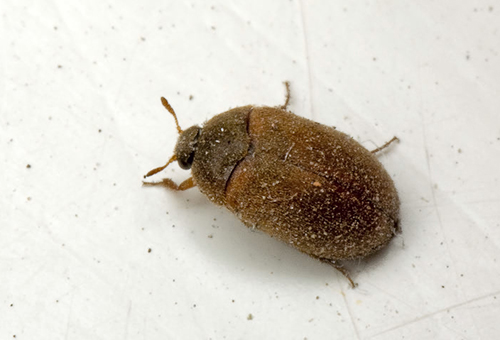
Kozheedy fly badly, but they like to eat hearty
Table: the most common types of kozheedov
| Name | What does it look like | Where does he live |
| Carpet | Bugs up to 4 mm brown | Lives on carpets, textiles, bedding. Eats particles of cat hair, crumbs, fabrics, human skin scales. |
| Ham | Oblong black body with gray-yellow wings | Eats open food |
| Shubny | On a black body there are 5 white dots | Lives on food |
| Brownie (museum) | Small black bug | Lives in flowers, books, stuffed animals |
| Beetle-skinned Smirnov | Brown body up to 3 mm | Inhabits window sills, wooden window frames |
| Frisch's skin beetle | Black body up to 9 mm | Food |
| Floral | It feeds on pollen, so it settles on plants |
What attracts kozheeda human dwelling
In nature, these pests live on the banks of swamps, reservoirs, in humid areas. But there are so many tasty things in a human's dwelling for an insect that they are not averse to settling in houses. Kozheedov are attracted by:
- natural fabrics (wool, fur, felt, silk, down);
- cardboard;
- glue (especially the one used for gluing the binding of books);
- wood products;
- food products (cereals, jerky, fish, bread);
- wallpaper;
- parquet;
- picture frames;
- wires and cables;
- garbage of plant and animal origin.
Reproduction
Kozheedy are very fertile, during her life the female lays more than a hundred larvae, giving 4–5 offspring per year. At the same time, eggs are very tenacious, they are able to live for years without food. And if there is a sufficient amount of food "at a party", then pupae develop to adults almost instantly. It is the larvae that cause the greatest harm, since they molt 6-7 times every 9-10 days, and before pupation they eat a lot and varied, gnawing passages in edible and inedible materials up to 10 cm.
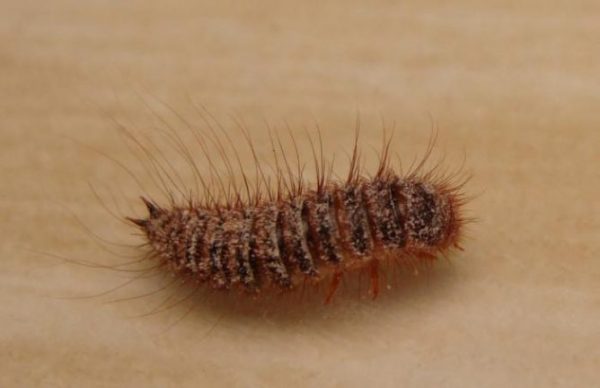
The larvae of the kozheed do not stop for a second: they are always in search of food
What is dangerous
Despite its modest size, kozheed is a source of danger to humans, as it is a carrier of infections, parasite eggs (including helminths). Bugs are not blood-sucking insects, but the human body is attracted by the smell of dead skin particles. Skin bites are quite painful, especially for children and women. The site of damage to the skin usually turns red, and due to the individual characteristics of the victim's body, it can swell and itch. To reduce the risk of infection, the site of the bite must be disinfected (for example, with chlorhexidine or vodka).
In addition to direct harm to the human body, kozheedy also cause indirect harm:
- spoil furniture, interior items, clothing;
- are an unaesthetic and unpleasant sight in the house.
What is kozheed
Of all the pests that penetrate our homes, the kozheed is the smallest. With the end of growth, the maximum body size of the beetle can be about three millimeters. The body of the kozheed has a hard shell of various shades of brown with barely noticeable stripes. Some types of kozheed are black. The shape of the body is round, or oblong.
Reproduction of kozheedov largely depends on the environmental conditions. The hotter and drier, the faster
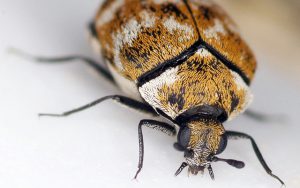 Kozheed
Kozheed
their reproduction takes place. The female is capable of laying several dozen eggs at a time. The larvae emerge, on average, in a month. If the conditions for life are unfavorable, for example, there is no food, then the larva of the harmful skin beetle may well do without it for 4-5 years! Caterpillars simply won't develop.
With enough food, an adult will form from a larva within a year. During her life, a female kozheeda can lay about a hundred eggs. If the conditions are right, the room is warm and dry - kozheedy reproduce up to five times a year.
The bugs get into the apartment in different ways. They can be brought with household items and wardrobe items from an infected home, on furniture, in a flower pot. These beetles can even fly from the street through an open window in the summer, as they can fly.
The kozheeda larvae are dark-colored furry caterpillars that molt up to six times a year before becoming an adult insect.
Adult insects must be destroyed so that they do not produce new caterpillars. It is noteworthy that the larvae of this beetle never sleep, so they have plenty of time to cause damage.
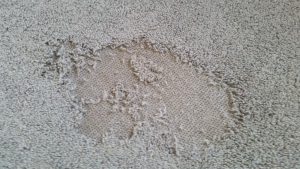 Carpet can also suffer from skin damage
Carpet can also suffer from skin damage
Judging by the name, the kozheed feeds exclusively on the skin. But this is not at all the case. Each of these nasty pests has different tastes and will cause different harm to your home, depending on the species.
The menu of these beetle larvae includes:
- natural fiber fabrics;
- leather and products from it;
- fur coats;
- furniture;
- books;
- Food.
The bites of these pests are directly dangerous for humans - they are quite painful. There is a high probability of contracting various infections and helminths through a skin bite.
Therefore, it is necessary to begin the fight against pests as soon as their presence was detected in your apartment. The bite is a small red dot on the body, sometimes it can be large red spots - this is due to the individual reaction of the body.
As soon as you find traces of bites, they should be immediately treated with a solution of hydrogen peroxide, alcohol, or other disinfectants.
Description of the pest
Many simply do not know what a leatherhead looks like, what characteristics it has, for this reason it is not immediately possible to determine its presence in an apartment. But it is worth highlighting several main qualities of this insect:
- body length is from 5 mm to 10 mm;
- the shell of the parasite is strong enough;
- has a brownish tint, usually it is dark or reddish;
- small stripes may be present on the surface, which may stand out in color;
- there are villi on the surface that cover the whole body;
- if you look closely at the insect, you can see a long bundle in the form of a ponytail.
Development and reproduction
To understand how long the fight against these pests can take place, let's look at the stages of development of the kozheed beetle. Females can lay their larvae anywhere: on the surface of various materials, in crevices in floors and walls, in furniture, and so on.
Depending on the temperature in the room, the period for the birth of a new population can be from two to fifty days. The drier and warmer the room, the faster the process goes. Each female during her life is capable of laying about a hundred eggs, and under the conditions of the temperature and humidity conditions of the apartment, skin beetles can give 4–5 offspring per year.
The larva of the kozheeda beetle molts 6–7 times with an interval of 5–9 days, and before the pupation stage it can gnaw out long (up to 10 cm) passages even in materials that are not used for food. Thus, it is the larvae that cause the greatest damage to the premises and to people.
Professional help
It is important to understand that severe pest infestation in premises requires exclusively professional treatment, preferably with the use of hot fog generators that combine thermal and chemical effects. The specialists of the Sanitary and Epidemiological Station are ready to offer their clients tremendous experience in the treatment of pests from both small living spaces and in the protection of warehouse, museum, retail space
After just one visit of specialists, it will be possible to easily get rid of any sources of danger, stop the invasion of adult bugs or their larvae, and also prevent their reappearance. The main thing is not to waste time and immediately contact the professionals when you find a problem.
Chemical exposure
What else can you do if you are overtaken by such a disaster as a skin beetle in an apartment. How to get rid of this scourge if the previous methods did not help?
In fairness, it is worth noting that simple physical elimination can only help if insects have recently settled in you and have not yet had time to greatly multiply. In other cases, the use of chemicals is most likely indispensable. Here are some recipes.
After thorough cleaning, sprinkle boric acid powder in all accessible areas, especially under carpets and near baseboards.Also for these purposes the drug "Borax" is suitable.
For processing small items, such as clothes, you can put them in a plastic bag along with the "Executioner" or "Tetrix" preparations. These are specialized products that do not leave any stains or odors. Processing should be carried out within 3-4 hours, after which things should be washed and dried.
There are also aerosols that kill both adults and larvae. Since such processing does not damage insect eggs, the procedure should be repeated 2-3 times with an interval of 10-14 days. As an example of aerosol preparations, one can cite "Difox" or the good old "Dichlorvos".
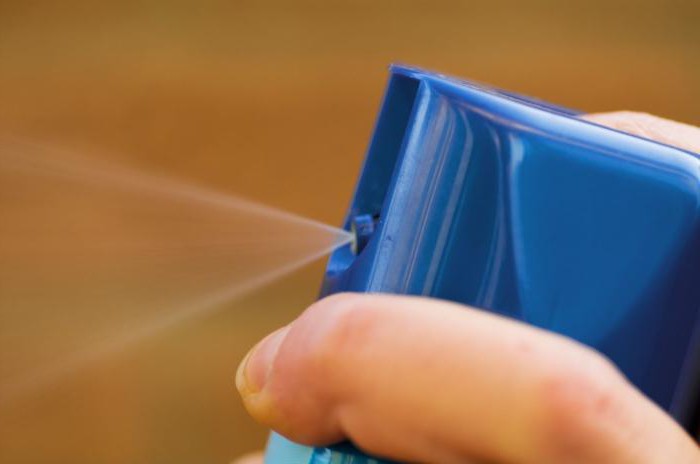
Also, anti-moth preparations are suitable for removing skin beetles, but it is better to use them as an additional remedy. It is worth remembering that antimal drugs have only a short-term effect, but at the same time they are endowed with a strong smell, by the way, not always pleasant.
Description of the species
Ham skinhead (Dermesteslardarius) is a beetle from the skinhead family. The adults grow up to 7-9 mm in size. The body is elongated, the upper part is convex, the lower part is flattened. Pronotum trapezoidal, widening at the elytra. The surface of the scutellum is black with sparse yellowish hairs.
The main color of rigid elytra is black, on the anterior part there is a wide band of yellow-brown or yellow-gray hairs. It is limited by a winding line. On the light background of the elytra, 6 black spots are clearly visible, 3 on each side. The dark part is punctate. Well-developed wings are folded under the elytra in a calm state. Imagoes are capable of short-distance flights.
The head is small, the eyes are weak. As you can see in the photo, the ham kozheed has short clavate antennae that are attached in front of the eyes. Insects are characterized by a gnawing mouth apparatus. The abdomen is black; each segment is bordered with red hairs. Legs of walking type with five-segmented tarsus.
What do the larvae look like
 Larvae kozheed
Larvae kozheed
The larva of the kozheed beetle is worm-like with pronounced hairs of different lengths on the body and a brush of straight coarse hair on the last segment. The larva actively feeds, damaging all types of organic substrate - wool, hair, feathers, skin, cereals and grain, sausages, milk powder, etc. Gastronomic preferences are not limited to organic matter. In the absence of familiar food nearby, it can eat synthetic materials. The larvae move quickly and actively. They prefer to settle in a fleecy, rough fabric.
The larva of the kozheeda beetle does not like light, which is explained by the absence of a chitinous cover and the imperfection of the mechanism of water retention. At first, after emergence from the pupa, negative phototaxis is also observed in adult skinworms, since there is still little melanin in the chitinous cover, which protects against ultraviolet rays.
The body of the larva is oval, fusiform. The legs are composed of 5 shortened segments. The claw merges with the leg segment.
The entire body of the larva is covered with chaetae of different appearance, length and color, represented by:
- hairs;
- bristles;
- scales.
A photo of the skinhead Smirnov shows an adult and larvae at different stages of development.
 Kozheed Smirnova
Kozheed Smirnova
The egg is ovoid, covered with a dense shell, which gradually turns yellow. The larva developing inside is visible through the shell.
Assessment of harm to humans
Penetrating into the territory of private housing, beetles spread through rooms and find a food source for themselves. At the same time, almost all property that is in a person's apartment is at risk. However, there are other hazards in contact with this pest. Considering that they feed on waste, microscopic impurities remain on the villi, where pathogens accumulate.
The danger lies in damage to expensive furniture and products.
Contact with humans increases the likelihood of infection.Moreover, it will be impossible to cure the disease until the kozheedy beetles are in the apartment. There is another danger to humans - painful bites. The reaction depends on the level of sensitivity of the organism.
These can be imperceptible red spots that remain after contact with a pest, or extensive redness. It should be noted that humans are not a source of food for skinheads. Insects bite, rather, by mistake or when they feel threatened.
The use of chemicals
Boric acid, concentrated solutions, aerosols, preparations in the form of tablets help get rid of the kozheed beetle. Liquid products will help you quickly withdraw. With their help, surfaces are treated, and the spray method is also used. The aerosol will give good results in a short time. When deciding how to remove beetles safely, it is recommended to consider boric acid powder. However, this option lasts longer.
Boric acid
It is enough to sprinkle the powder on the floor, along the baseboards, on window sills, under carpets, behind furniture. It is necessary to process all possible places where bugs can live and have already been noticed. Boric acid powder is completely safe for animals and humans.
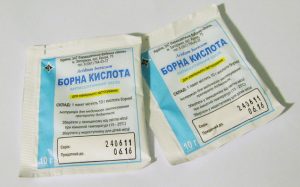
Concentrated liquids
If kozheedy are wound up in the apartment, how to get rid of them quickly? Concentrates are involved. These are liquids that contain a significant dose of insecticide. Poisonous substances are dangerous for people, pets, however, they can effectively deal with bugs. Concentrates are recommended for use at facilities with a high level of contamination.
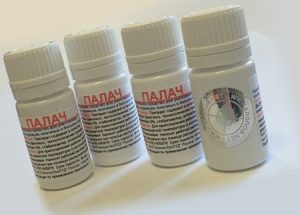
All surfaces and objects are treated with the tool. Most of the preparations do not leave any marks after application and spraying, but if there are doubts when using an insecticide on a valuable item, you can wrap it with polyethylene, installing a container with poison and tightly closing the film. The duration of exposure to the chemical is at least 2 hours.
Aerosols
These substances have no effect on eggs. The principle of action of aerosols is similar to how a concentrate works, however, in this case, the substance contains a lower dose of insecticide. The main plus is its convenient use. After a few weeks, the surfaces are re-treated, since during this time larvae may appear from the eggs. Popular drugs: Karbofos, Dichlorvos, Clean House, Reid, Raptor.
Pills
When deciding how to get rid of skin bugs, they use moth control agents, for example, Antimol. However, this method is more suitable for the destruction of larvae, since they feed on solid food. The adult prefers a liquid food source. For this reason, tablets are usually used in conjunction with other drugs. Consider the strong odor they emit, as there is a risk that furniture and clothing will be saturated with this aroma.
Interesting video: What is the danger of the kozheed beetle
Types of kozheed
Kozheedy are small brown or black bugs. Despite the accepted name, they feed not only on the skin. For these pests, there are few items that are inedible. They can eat not only food, but also fabrics, glue, paper, wood, plastic, concrete, and more.
Several species of insects are called kozheedami. This is a common name for them, accepted by the people.
Main types:
- Ham leathery. In Eurasia, this species is considered the most common. Insects quickly penetrate houses where they make masonry. Beetles have an oblong black body with grayish-yellow wings.
- Carpet beetle. This is a separate group of pests of 4 subspecies. All representatives have a body from 2 to 4 mm brown. They feed on small organic residues - pieces of cat hair, food crumbs, particles of human skin, etc. A feature is that only larvae feed, but adults consume what they accumulated at an early stage of development.
- Fur coat kozheed. This variety is considered the most harmless.Despite the name, such insects feed only on food. The body is black with 5 spots of white on the back.
- Museum and brownie. These varieties are commonly found on stuffed animals and in flowers. They rarely enter the house.
- Kozheed Smirnova. Has a brown body no more than 0.3 cm in length. It can usually be seen in window frames. It is considered very common.
- Kozheed Frisha. It is a rare species for residential buildings, like a museum variety. Has a black body.
Ways to deal with the beetle-kozheed
Fighting a skinhead in an apartment is a rather difficult task. However, there are ways the beetle is powerless against.
Beetles do not tolerate moisture. Therefore, all hard-to-reach and dark places must be thoroughly washed.
Often kozheedy penetrate into the house through window frames, therefore, special attention should be paid to the interframe space.
Vacuum all "suspicious" places. After cleaning, you must carefully check the dust container and clean it. The steam generator is also an easy and effective tool in the fight against pests.
Frost and cold are deadly for beetles
Therefore, it is advisable to take carpets, furs, and rugs outside in winter and clean them with snow, knock them out.
Boric acid traps. In hard-to-reach and dark places, you can put pieces of bread treated with boric acid. An insect, eating such bread, is simply poisoned.
Items that are stored on the shelves of cabinets or on the mezzanine can be folded into bags along with such products as "Tetris" or any other that destroy beetles.
Treat surfaces, crevices and dark places with Permitrin solution. This drug is sold in any pharmacy as a remedy for head lice and relieves the house of skin beetles for a long time.
Sprigs of lavender or wormwood can be placed in cabinets and in the corners of dark places. Kozheedy cannot stand these plants.
You can also get rid of the skin in the apartment with the help of traditional chemicals.
But, at the same time, it is important to take into account that aerosols will not kill the larvae, but chemical tablets, on the contrary, will perfectly cope with them.
How to deal: effective methods
Initially, find a hideout for the skinheads. Parasites are looking for secluded places, away from direct sunlight and moisture. Pests are cunning, so you need to inspect the entire apartment. When a clutch of eggs is found, 95% success is guaranteed. It will not be possible to find one egg, but a large number is quite possible. Getting rid of the beetle offspring is not difficult - just crush them.
If parasites infest the house in winter, take things out in the cold, the beetles will die.
Beetles are removed from carpets with a vacuum cleaner. Thorough spring cleaning will increase the chances of getting rid of pests, but will not be 100% guaranteed. The larvae develop for a long time, after a few weeks the beetles will again fill the dwelling. What can you do to get rid of skin problems forever? The answer is simple - use chemicals. The choice of drugs against parasites is very large, study the advantages and disadvantages of each group of poisons, choose the right one.
Chemicals

Effective drugs and their use:
- boric acid powder. Spread the preparation under the skirting boards, along the perimeter of carpets, on window sills. The substance is safe for humans, does not have a special smell, does not interfere with the inhabitants of the house to lead their usual way of life. It is forbidden to use a chemical if there are pets, small children in the house. Boric acid powder will not bring significant damage to the health of households, but there are cases of food poisoning, the appearance of an allergic reaction;
- special concentrates. They are used in case of severe contamination of the premises. It is recommended to carry out a complete treatment of the apartment, and not just application to individual items. Most of the products do not reflect on surfaces in any way, do not leave traces.With delicate things, do it differently: wrap them in a bag, put a container with an insecticide, wrap them up for several hours. The most commonly used Executioner, Tetrix. Thorough cleaning at home will eliminate the parasites in a few weeks;
- aerosols. The substances are similar in principle of action to the previous agents, but they do not include many active ingredients. The insecticide is spread over the surface and acts slowly but effectively. Adults are killed by aerosols by penetrating the chitinous layer, which leads to paralysis and death. The larvae die faster because they do not have a chitinous layer. Drugs in this category are cheaper, their consumption is higher than concentrates. Often used: Raptor, Raid, Clean House, Diclofos;
- pills. They produce special pills designed to fight moths, some drugs also act on skinheads, for example, Antimol. The larvae will eat pills, but adults prefer liquid food. The process of baiting beetles with tablets is long and is often used as an aid. Chemicals have a specific scent, consider this aspect when dealing with parasites.
Kozheedy beetles, filling the apartment, cause a lot of inconvenience to the owners. Pests are excellent at camouflaging due to the brown color, which merges with the furniture in the house. The process of removing parasites can be costly and time-consuming. Be sure to destroy all individuals, even one larva can cause re-infection of the premises. If you suspect the first signs of the presence of a kozheed in the house (holes in the furniture, the presence of holes in the windowsills), immediately start dealing with intruders.
Important! Wear a protective gown or rubber gloves, gauze bandage while handling the room. Take all residents outside while using insecticides (this also applies to pets, indoor plants)
Observe the rules specified in the instructions, it is advisable not to enter the house for several hours after processing.
Folk recipes
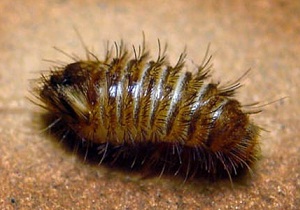
Natural remedies show excellent results, but are often used as preventive measures.
Natural remedies cannot completely eliminate insects, but they can scare intruders away from your home:
- put cotton pads moistened with lavender, tansy, lemon balm in cabinets and cupboards in the kitchen. Such aromas reliably scare off parasites;
- kozheedy are afraid of boric acid, you can put the product in a saucer, put in often inhabited places;
- table vinegar will come in handy. Dilute a tablespoon of vinegar in a liter of hot water, pour the solution into a spray bottle, spray window sills, baseboards, shelves and cabinets. The smell of vinegar is unpleasant for insects, intruders will quickly leave your home, looking for more suitable living conditions.
Where the skinhead lurks and what it eats
The fight against kozheedy begins with finding their habitat. To do this, you need to carefully check:
- heating radiators and other heat sources;
- gaps in skirting boards;
- cabinets;
- beds;
- upholstered furniture (sofas, upholstered chairs, etc.);
- carpets (including those made of artificial material).
One of the most common places where both the beetle and the kozheeda larva can live are containers with cereals and other dry products in the kitchen. This is especially true for large volumes, "in reserve", which have been stored for a long time. Clusters of moths can also be found there.
Kozheedy can eat:
- leather goods (including leather upholstery and accessories);
- natural fabrics (clothing, textiles, upholstery);
- fur products (fur coats, hats, etc.);
- wood coatings;
- cellulose (paper, books);
- carpet pile.
For food from the human menu, they have a special addiction to dry foods, where they eat and live comfortably.Therefore, the contents of cans and containers, as well as stale dried fish, should simply be thrown away, since these products are inhabited by larvae and contaminated with their excrement.
Reasons for the appearance
Where does the kozheed come from? Why does he appear in apartments, and what factors cause his appearance? It is impossible to answer exactly this question, because this parasite can appear in almost any room, regardless of living conditions.
The insect's routes of entry can be as follows:
- In warm weather, kozheedy often enter the apartment through open doors and windows. The fact is that they have wings, so they can safely move through the air;
- Sometimes they enter the premises from neighbors;
- Insects can be carried on shoes or clothing;
- Pets can introduce parasites.
The reasons for the appearance of insects can be different, but it is imperative to be able to determine the presence of these creatures. In this case, it is worth knowing the signs of the presence of parasites in the apartment. And if they are found, you must immediately proceed to active destruction.

